Okeanos Aggressor II, Caño Island, Costa RicaContents of this Issue: Alami Alor, Pulau Alor, Indonesia Buoyancy Cell Failure Causes Diver Fatality A Caribbean Influx of Deadly Weed Undercurrent Receives $1000 Environmental Grant Okeanos Aggressor II, Caño Island, Costa Rica Oceanic/Hollis Regulator Recall Tulsa Diver Bent in Cozumel Gets Insurance Shock Plastic Packaging and the Diving Industry Discover Scuba Diving Course Leads to Fatality Reminiscing about Being Adrift at Sea Blubber For SEALs and Penguin Feathers Editorial Office: Ben Davison Publisher and Editor Undercurrent 3020 Bridgeway, Suite 102 Sausalito, CA 94965 well, it’s sure not Cocos Island from the July, 2018 issue of Undercurrent
Dear Fellow Diver, Beep, beep, beep...beep, beep, beep ... Sleeping in my lower bunk on the Okeanos Aggressor II off Caño Island, my brain cells gradually woke up to the constant chirp of a smoke alarm -- but where was it coming from? Stumbling into the hallway, there were already a couple of other dazed people looking around. We made our way up two flights of stairs to the muster station. Was I supposed to be wearing my life jacket? Expecting to be greeted by the Captain barking orders, I heard -- quiet. Only the hall smoke detectors would trigger an alarm in the Captain's quarters, not the individual cheap-looking cabin alarms. I opened the bridge door and yelled for the Captain. While he was on his way, another passenger came up with the malfunctioning culprit alarm in his hand, from a cabin whose residents didn't even know the chirping came from their room. All said and done, a third of the guests mustered in the correct spot, only two wore life jackets, a third mustered on the dive deck, and the other third slept right through it! Hmmm.
While Caño Island is a dayboat trip from many resorts on Costa Rica's southern coast, off Oso Peninsula, it's a 12-hour overnight steam from Puntarenas, where the (120-foot/36m long) Aggressor moors (from there, she steams to Cocos Island, her primary destination). I booked this itinerary hoping that because the waters of Caño Island are a marine preserve, diving would be somewhat like Cocos (or maybe Mexico's Socorro) with a shorter, less arduous crossing. It wasn't to be. Our morning check-out dive was at Barco Hundido, where I swam among schooling porkfish and snappers, a starry moray, guitar ray, plus two other morays. While the surface temperature was 84°F (29°C), it dropped to 77°F (25°C) at 60 feet (18m), and visibility was a disappointing 30 feet (9m) or so, which didn't concern me, because checkout dives are rarely at the better sites. In the haze, my buddy and I lost the rest of the group, but we had the captain as our guide -- oops, lost him too! We moseyed around until we finally stumbled into everyone as the dive ended.
A better dive was at Cueva de Los Tiburones, where I spotted a turtle on my way down the line. Two white-tips hung out in a small cave, but kicking through the 10-foot (3m) surge to reach them was a challenge, for sure. A juvenile peacock razorfish tried its best to look like a floating leaf. Tube blennies popped from old barnacle holes on the rocks that dominated the topography. Some soft corals and plenty of sea fans added a bit of color, but because of the current and surge, the stunted sea fans were no taller than eight inches(20cm), and the soft corals were no taller than 10 inches (25cm). And there were no hard corals. But on board, there was plenty of food. Pre-breakfast started as early as 5:30a.m., with cereal and toast, then after the 7:00 a.m. dive (the two others were at 10:30 a.m. and 2:30 p.m.), Eduardo served up made-to-order eggs, bacon or sausage, sometimes pancakes, fruit, pastries, and yummy veggie/fruit smoothies. May the overeating begin! Lunch and dinner often started with delicious home-made soup and salad, followed by a full meal including fish, chicken, or pizza, and dessert, served buffet style, a little crowded at the bar, but the line moved quickly. One night was chicken/beef/fish BBQ, but without the sauce. Afternoon snacks usually included banana smoothies and cookies or cake, and it seemed as if my wetsuit got tighter. Eduardo met special meal requirements or requests, though one guest, who failed to realize a salad had corn in it, spit it out, took a Benadryl, and set her EpiPen on the table. Sodas, lemonade, beer, and wine were complimentary. After a few dives, I realized that the poor visibility was a given. After all, the Costa Rican coast is a rainforest, and it rained almost every day on my April trip. Probably my best visibility was 50 feet (15m), but generally, it was less. (Later, I was told January-February has the best visibility, about 60 feet/18m). I was frustrated because there were lots of schooling jacks and snappers, but I couldn't see most of the action. The Aggressor advertised water temperatures ranging from 72-84°F (22-29°C), so I figured it would be mostly around 80°F (27°C) with an occasional colder upwelling, but I didn't expect a major thermocline at 40 feet (12m), with a constant 72°F (22°C) at 80 feet (24m). We dived from two inflatable pangas, with local guides Anibol, Facundo, and Captain Carlos switching every day. By the middle of the week, our panga had one guide, but the other panga usually had two, as one customer complained about how fast the guide swam, and that he wasn't paying her enough attention. (This same woman thought she would have a private cabin -- without paying extra -- and when a roommate arrived, she continued to act like it was hers alone, hogging the closet, drawers, and bathroom.) A day after the guide was harangued, he waggled a finger at me as I held onto some barnacles trying not to be flung 20 feet (6m) backward by the surge. I guess it was a carryover from the day before, since I never saw him reprimand anyone during the week, though everyone grabbed rocks and barnacles in front of him, and he, too, occasionally braced his hands and fins on the bottom. It was impossible not to.
Gearing up on the main boat was easy but congested, thanks to the layout of the individual storage bins. I found it easier to take my wetsuit up to the sundeck, where I could sit in a chair and pull it on. The sundeck had lots of shade, along with some tables (that were never wiped clean) and many chairs -- it was a popular place in the evening. On the main deck, another sitting area was a fantastic place to watch the sunsets. There were a large camera table and one large camera rinse tank, with a couple different charging stations. They recommended charging in the cabins only while we were present.
Speaking of staying warm, the three showers on the stern, down a few steps from the dive deck, where the ocean surged in and out, were heaven, with warm to hot water and great pressure. In fact, that's where I took most of my showers, after attempting a couple in my cabin with little pressure and either cold water (try #1) or scalding water (try #2). My least favorite dive was at Cirujano One (surgeon in Spanish). The visibility was poor, with mostly surge and funky currents. Small schools of barracuda swam, and a couple of nudibranchs slogged along the rock. After 40 minutes I got cold and bored, so I floated above my buddy, willing him to look up at me, but he zoomed off when he thought he lost me. Trying to follow the group's mass of bubbles from a shallower depth for a couple of minutes, I gave up and headed to the sunlight. Midway through the week, two park skiffs took those who wished on a pounding one-hour ride to Corcovado National Park. During a ¾-mile loop, I spotted plenty of birds, raccoon-like coatis, and capuchin monkeys, along with hundreds of tiny crabs on the beach. If someone didn't want to do this tour, there was no dive to replace it. Another afternoon, those interested were taken to a beach on nearby Caño Island for an hour. They offered no night dives, even though Aggressor's "Know Before You Go" section on their website said there would be three. On board, I was told night dives had been ruled out by the park system two years ago. I can understand why, given the surge and low visibility, but why does the Aggressor maintain this fiction on its website? To make up for no night dives plus missing a dive for the tour, we did an optional fourth dive the second-to-last day, at Bajo de Diablo. As soon as I descended, I started laughing. The visibility was about 10 feet, just like our local quarry! However, I spent an interesting dive looking in little holes, spying tiny mantis shrimp, lots of tube blennies, two lobsters, a school of mullet, and a small school of jacks -- at least I can't see those things in a quarry.
So, this is no Cocos and no Socorro. With low visibility, surge, currents that seemed to go every which way, and cold, the diving was frustrating. It's one trip I won't be doing again. Thankfully, the Okeanos Aggressor is a comfortable craft with great deck showers, tasty food, a friendly all-male staff, a mostly congenial group of guests. And, by making every dive, I became an Iron Diver! PS: The night before we disembarked, three guests started feeling ill, and one spent her flight home vomiting into the plane's air-sick bags. As a doctor, she figured the cause was most likely a norovirus (maybe brought back from the park tour?) or food poisoning. Not a fun way to end a dive trip. -- J.R.S Our undercover diver's bio: Having been certified since the early '70s, I've logged about 3800 dives. While I hate the stress of travel, I buck up and love diving around the world. My best dives were in the '90s at Sipadan, when you were still allowed on the island, with showers in the jungle and sinks hanging on trees. I plan on diving until my last breath, even if I have to crawl into the water.
|

I want to get all the stories! Tell me how I can become an Undercurrent Online Member and get online access to all the articles of Undercurrent as well as thousands of first hand reports on dive operations world-wide
| Home | Online Members Area | My Account |
Login
|
Join
|
| Travel Index |
Dive Resort & Liveaboard Reviews
|
Featured Reports
|
Recent
Issues
|
Back Issues
|
|
Dive Gear
Index
|
Health/Safety Index
|
Environment & Misc.
Index
|
Seasonal Planner
|
Blogs
|
Free Articles
|
Book Picks
|
News
|
|
Special Offers
|
RSS
|
FAQ
|
About Us
|
Contact Us
|
Links
|
3020 Bridgeway, Ste 102, Sausalito, Ca 94965
All rights reserved.

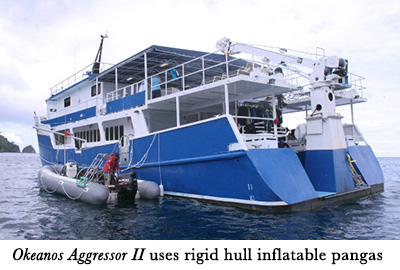 My April trip to Costa Rica started off well with an overnight at the Holiday Inn Express San Jose Forum. In the morning, after a good complimentary breakfast, the luggage truck and passenger bus arrived at 2:20 p.m. for our 60-mile drive to Puntarenas. After boarding the boat, we had a briefing, including what to do if the alarms went off (I thought everyone had paid attention), and I was shown to my downstairs cabin, pretty much the same as the others, with bunk beds, ensuite bathrooms, and a small closet with three drawers. Upstairs cabins were more luxurious, roomier -- and more expensive. Because the boat has a water maker, one would presume water would be fine for drinking, but no, it was only for brushing teeth and showering. Time to clean out the pipes, I guess.
My April trip to Costa Rica started off well with an overnight at the Holiday Inn Express San Jose Forum. In the morning, after a good complimentary breakfast, the luggage truck and passenger bus arrived at 2:20 p.m. for our 60-mile drive to Puntarenas. After boarding the boat, we had a briefing, including what to do if the alarms went off (I thought everyone had paid attention), and I was shown to my downstairs cabin, pretty much the same as the others, with bunk beds, ensuite bathrooms, and a small closet with three drawers. Upstairs cabins were more luxurious, roomier -- and more expensive. Because the boat has a water maker, one would presume water would be fine for drinking, but no, it was only for brushing teeth and showering. Time to clean out the pipes, I guess.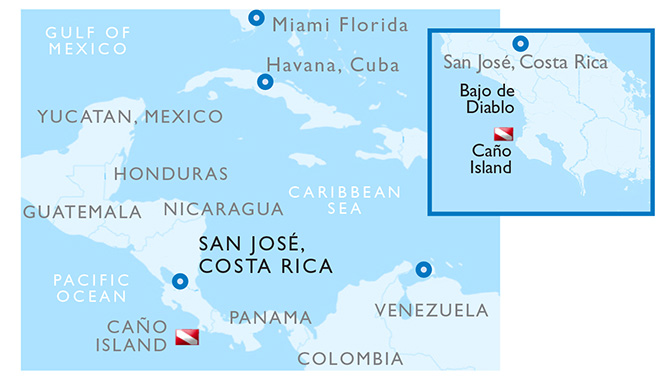
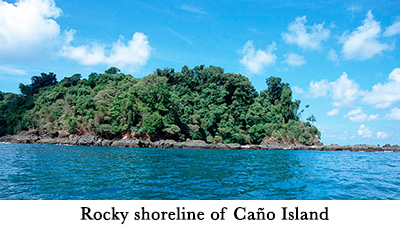 Tanks, all 80 cu. ft. (11-liter) aluminum, and gear stayed in the pangas the entire trip, filling done with long hoses. This meant that BCs and regulators were in the sun all day, occasionally rinsed by the rain. The pangas were rigid-hulled inflatables with forward controls. A wooden tank holder ran down the middle, which made space tight and donning fins awkward. The panga driver would check Nitrox (usually 32). At dive sites, we backrolled in one-by-one, then went down the line. Surfacing after the maximum 55-minute dive, I handed up my weights and gear and climbed the ladder's wide wooden steps. They carefully laid cameras on a thick piece of foam at the bow, but the area was crowded with just two large camera rigs. There was no way to rinse a camera on the panga, but one diver brought his own water-proof camera bag that he could fill with water, or at least keep his camera out of the sun.
Tanks, all 80 cu. ft. (11-liter) aluminum, and gear stayed in the pangas the entire trip, filling done with long hoses. This meant that BCs and regulators were in the sun all day, occasionally rinsed by the rain. The pangas were rigid-hulled inflatables with forward controls. A wooden tank holder ran down the middle, which made space tight and donning fins awkward. The panga driver would check Nitrox (usually 32). At dive sites, we backrolled in one-by-one, then went down the line. Surfacing after the maximum 55-minute dive, I handed up my weights and gear and climbed the ladder's wide wooden steps. They carefully laid cameras on a thick piece of foam at the bow, but the area was crowded with just two large camera rigs. There was no way to rinse a camera on the panga, but one diver brought his own water-proof camera bag that he could fill with water, or at least keep his camera out of the sun.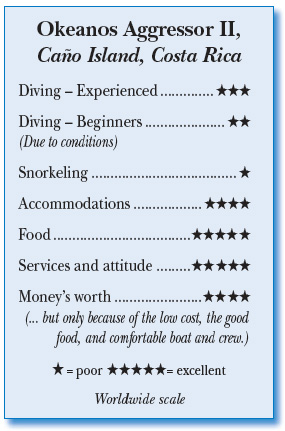 My favorite dive site (at least the first time we dove it) was Faro Perdido, where mobula rays did fly-bys in the ripping current, and a huge school of barracuda swirled about, while a couple of white-tips swam around. On the way down, I saw numerous little blue flecks; when I tried to touch them, they scurried away. I've seen these on many other dives, both in Atlantic and Pacific destinations, and have never figured out what they are. (Email Undercurrent if you know.) When I dived the same site at 10:30 a.m. on the last day, I had an entirely different dive. It was rainy and almost like a night dive on the bottom -- some of the fish looked like they were still sleeping! And colder -- 72 °F (22°C) on the bottom. While our guide diligently looked for small things, most of us were 20 feet (6m) above him, trying to stay warm above the thermocline.
My favorite dive site (at least the first time we dove it) was Faro Perdido, where mobula rays did fly-bys in the ripping current, and a huge school of barracuda swirled about, while a couple of white-tips swam around. On the way down, I saw numerous little blue flecks; when I tried to touch them, they scurried away. I've seen these on many other dives, both in Atlantic and Pacific destinations, and have never figured out what they are. (Email Undercurrent if you know.) When I dived the same site at 10:30 a.m. on the last day, I had an entirely different dive. It was rainy and almost like a night dive on the bottom -- some of the fish looked like they were still sleeping! And colder -- 72 °F (22°C) on the bottom. While our guide diligently looked for small things, most of us were 20 feet (6m) above him, trying to stay warm above the thermocline.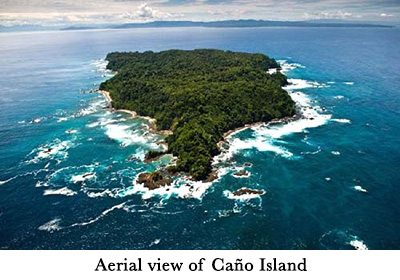 Most dive sites were on the
west side of Caño, and Bajo de
Diablo was where we did the most
dives -- five -- I assume due to
current, surge, and visibility
issues. There were always sharks
and rays, schooling jacks, sometimes
mobulas, and lots of surge.
The surge became fun if there
was enough space, although I got
flung into a couple of people with
unexpected 15-foot (4.5m) surge a
couple of times.
Most dive sites were on the
west side of Caño, and Bajo de
Diablo was where we did the most
dives -- five -- I assume due to
current, surge, and visibility
issues. There were always sharks
and rays, schooling jacks, sometimes
mobulas, and lots of surge.
The surge became fun if there
was enough space, although I got
flung into a couple of people with
unexpected 15-foot (4.5m) surge a
couple of times. Divers Compass: Cost of trip: $2595 with a $200 Island Dreams discount
Divers Compass: Cost of trip: $2595 with a $200 Island Dreams discount 